Much more than a smugglers tale: the archaeology of South Landing
10/03/2016 | Megan Clement
South Landing, situated south of Flamborough Head on the Yorkshire coast is home to stunning views and an exciting past. Shortlisted for the BBC’s Countryfile Magazines Beach of the Year 2015/6, its distinctive yet internationally important white cliffs stand 400 feet high in some places.
This is home of the Yorkshire Wildlife Trust’s Living Sea Centre who focus on educating, preserving and celebrating the unique wildlife of the marine environment. However, the site is not just home to wildlife but also some incredible yet sometime overlooked archaeological remains.

On the trail down to the beach just before reaching the foreshore, is the site of one of the earliest lifeboat stations in the country. Built in 1871, the lifeboat station was one of a pair, the other being situated at North Landing. The original station at South Landing was shut in 1934, when the North Landing site acquired a new motorised boat, reducing the need for two stations. However in 1993 the original building was demolished so the RNLI could build a new station at South Landing, and close original North Landing lifeboat station permanently. In the 67 years the two lifeboat stations worked together they saved over 540 lives. Although not the original building the remains of previous lifeboat crew remain. Above a door in an extension built on the current lifeboat station in 2009, are bricks with graffiti of the names of members of previous lifeboat crews.

Continuing down onto the beach one must look carefully for the archaeology there. South Landing has been a port since 1323 and remains of it historical fishing industry is represented by much more than cobles. Further on from the lifeboat slipway are the remains of two inconspicuous possible fish hullies. These are temporary storage used by fishermen to hold live fish and shellfish, to keep them fresh until they were taken away to be sold. The remains here are likely post-medieval in date and are constructed of the local chalk mortared together. No archaeological recording have been done on these hullies and they are not mentioned anywhere.

Heading eastwards along the cobble beach there are the remains of large boulders which are seemingly out of place. This is the remains of a 16th century pier, although there was a pier at South Landing mentioned in c.1400 this was likely wooden and was destroyed in 1551. It was rebuilt again post-1562 but destroy a second time in c.1569 and apparently never rebuilt. The remains of the pier present today are likely the remains of this second stone built pier. Allegedly this is pier that Mary Stuart, Queen of Scots, anchored at in August 1561 on her way from France to claim the throne of Scotland. What remains of the pier now are two lines of large stones. It was archaeologically recorded in the 1980s, but because it is at risk of erosion and severe storms it needs to be monitored carefully.

There foreshore and cliffs of South Landing and Flamborough are archaeologically rich and diverse; from prehistoric with the huge bank of Dane Dyke to the rapidly eroding Iron Age promontory fort at Briel Nook, all the way to the remains of WW2 military archaeology such as the numerous pillboxes that litter the landscape and even barrage balloon moorings to help protect the Lighthouse at Flamborough Head.
CITiZAN hope to undertake some work at South Landing in the Summer of 2016, focusing on the medieval pier and the fish hullies. Keep up to date with events using events page on the website or signing up to the newsletter.








